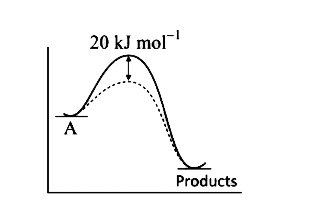For following reactions
A400K−−→ Product
A200K−−−−−→catalyst Product
it was found that the Ea is decreased by 20 kJ/ mol in the presence of catalyst. If the rate remains unchanged, the activation energy for catalysed reaction is ( Assume per exponential factor is same ) :
105 kJ/mol
198 kJ/mol
75 kJ/mol
135 kJ/mol
The correct Answer is:C
To solve the problem, we need to analyze the given reactions and apply the Arrhenius equation, which relates the rate constant of a reaction to its activation energy and temperature.
1. Identify the Given Information:
- For the uncatalyzed reaction at 400 K, let the activation energy be Ea1.
- For the catalyzed reaction at 200 K, the activation energy is Ea2.
- It is given that Ea2=Ea1−20kJ/mol.
- The rate of both reactions remains unchanged.
2. Write the Arrhenius Equation:
The Arrhenius equation is given by:
k=Ae−EaRT
where:
- k = rate constant
- A = Arrhenius constant (frequency factor)
- Ea = activation energy
- R = universal gas constant (8.314 J/(mol·K))
- T = temperature in Kelvin
3. Set Up the Equation for Both Reactions:
For the uncatalyzed reaction at 400 K:
k1=Ae−Ea1R⋅400
For the catalyzed reaction at 200 K:
k2=Ae−Ea2R⋅200
4. Since the Rates are Unchanged:
Since k1=k2, we can equate the two equations:
Ae−Ea1R⋅400=Ae−Ea2R⋅200
Canceling A from both sides gives:
e−Ea1R⋅400=e−Ea2R⋅200
5. Taking Natural Logarithm:
Taking the natural logarithm of both sides:
−Ea1R⋅400=−Ea2R⋅200
This simplifies to:
Ea1400=Ea2200
6. Substituting Ea2:
Substitute Ea2=Ea1−20:
Ea1400=Ea1−20200
7. Cross-Multiplying:
Cross-multiplying gives:
200Ea1=400(Ea1−20)
Simplifying this:
200Ea1=400Ea1−8000
Rearranging gives:
200Ea1−400Ea1=−8000
−200Ea1=−8000
Ea1=40kJ/mol
8. Finding Ea2:
Now, substitute Ea1 back to find Ea2:
Ea2=Ea1−20=40−20=20kJ/mol
Final Answer:
The activation energy for the catalyzed reaction is Ea2=20kJ/mol.
- For the uncatalyzed reaction at 400 K, let the activation energy be Ea1.
- For the catalyzed reaction at 200 K, the activation energy is Ea2.
- It is given that Ea2=Ea1−20kJ/mol.
- The rate of both reactions remains unchanged.
The Arrhenius equation is given by:
k=Ae−EaRT
where:
- k = rate constant
- A = Arrhenius constant (frequency factor)
- Ea = activation energy
- R = universal gas constant (8.314 J/(mol·K))
- T = temperature in Kelvin
For the uncatalyzed reaction at 400 K:
k1=Ae−Ea1R⋅400
For the catalyzed reaction at 200 K:
k2=Ae−Ea2R⋅200
Since k1=k2, we can equate the two equations:
Ae−Ea1R⋅400=Ae−Ea2R⋅200
Canceling A from both sides gives:
e−Ea1R⋅400=e−Ea2R⋅200
Taking the natural logarithm of both sides:
−Ea1R⋅400=−Ea2R⋅200
This simplifies to:
Ea1400=Ea2200
Substitute Ea2=Ea1−20:
Ea1400=Ea1−20200
Cross-multiplying gives:
200Ea1=400(Ea1−20)
Simplifying this:
200Ea1=400Ea1−8000
Rearranging gives:
200Ea1−400Ea1=−8000
−200Ea1=−8000
Ea1=40kJ/mol
Now, substitute Ea1 back to find Ea2:
Ea2=Ea1−20=40−20=20kJ/mol
The activation energy for the catalyzed reaction is Ea2=20kJ/mol.
Topper's Solved these Questions
- CHEMICAL KINETICS BOOK - VMC MODULES ENGLISHCHAPTER - CHEMICAL KINETICS EXERCISE - JEE Advanced (Archive)
52 Videos
- CHEMICAL KINETICS BOOK - VMC MODULES ENGLISHCHAPTER - CHEMICAL KINETICS EXERCISE - Level-2 ( Numerical Value Type for JEE Main )
15 Videos
- CHEMICAL EQUILIBRIUMBOOK - VMC MODULES ENGLISHCHAPTER - CHEMICAL EQUILIBRIUMEXERCISE - IN-CHAPTER EXERCISE - G
10 Videos
- CHEMICAL THERMODYNAMICS BOOK - VMC MODULES ENGLISHCHAPTER - CHEMICAL THERMODYNAMICS EXERCISE - IN - CHAPTER EXERCISE - L
10 Videos
Similar Questions
For the following reaction,
A500K−−→ Products
A400K/catalyst−−−−−−−−→ Product
If (−d[A]dt)500K=−(d[A]dt)400K
no catalyst in presence of catalyst Then Ea is approximately :

View SolutionAt 227∘C , the presence of catalyst causes the activation energy of a reaction to decrease by 4.606Kcal.The rate of the reaction will be increased by :−
View SolutionA hydrogenation reaction is carried out at 500K. If the same reaction is carried out in the presence of a catalyst at the same rate, the temperature required is 400K. Calculate the activation energy of the reaction if the catalyst lowers the activation barrier by 20kJmol−1.
View SolutionRate of reaction in absence of catalyst at 700 K is same as in presence of catalyst at 500 K. If catalyst decreases activation energy barrier by 30 kJ/mole, determine activation energy in presence of catalyst. (Assume 'A' factor to be same in both cases)
View SolutionRate of reaction in absence of catalyst at 700 K is same as in presence of catalyst at 500 K. If catalyst decreases activation energy barrier by 30 kJ/mole, determine activation energy in presence of catalyst. (Assume 'A' factor to be same in both cases)
View SolutionA reaction is carried out at 600K. If the same reaction is carried out in the presence of catalyst at the same rate and same frequency factor, the temperature required is 500K. What is the activation energy of the reaction, if the catalyst lowers the activation energy barrier by 20KJ/mol ?
View SolutionThe rate constant of a reaction at temperature 200 K is 10 times less than the rate constant at 400 K. What is the activation energy (Ea) of the reaction ? (R = gas constant)
View SolutionA catalyst decreases Ea form 100KJmol−1 to 80KJmol−1. At what temperature the rate of reaction in the absence of catalyst at 500K will be equal to rate reaction in the presence of catalyst ?
View SolutionThe activation energy for a first order reaction is 60 kJ mol−1 in the absence of a catalyst and 50 kJ mol−1 in the presence of a catalyst. How many times will the rate of reaction grow in the presence of the catalyst if the reaction proceeds at 27∘C ?
View SolutionThe activation energy for a first order reaction is 60 kJ mol−1 in the absence of a catalyst and 50 kJ mol−1 in the presence of a catalyst. How many times will the rate of reaction grow in the presence of the catalyst if the reaction proceeds at 27∘C ?
View Solution